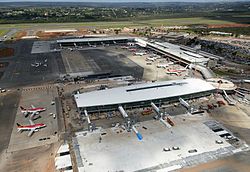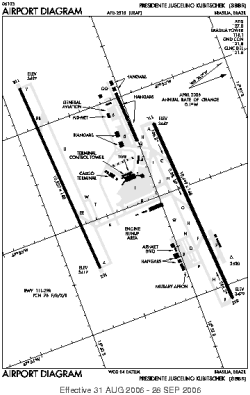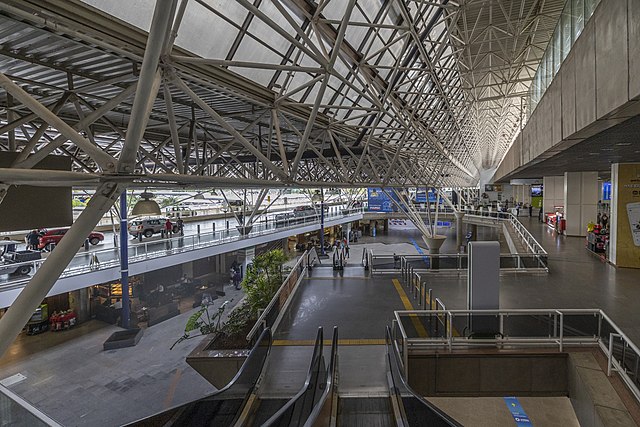Brasília International Airport
International Airport serving Brasília From Wikipedia, the free encyclopedia
International Airport serving Brasília From Wikipedia, the free encyclopedia
Brasília–President Juscelino Kubitschek International Airport (Portuguese: Aeroporto Internacional de Brasília–Presidente Juscelino Kubitschek) (IATA: BSB, ICAO: SBBR), also known as the Brasília International Airport, is the international airport serving Brasília and the surrounding Federal District. Since April 20, 1999, the airport is named after Juscelino Kubitschek (1902–1976), the 21st President of Brazil.[5] The airport is located in the administrative region of Lago Sul, 5 kilometers from Brasília's South Wing (Asa Sul). It is operated by Inframerica.[6]
Brasília–President Juscelino Kubitschek International Airport Aeroporto Internacional de Brasília–Presidente Juscelino Kubitschek | |||||||||||||||
|---|---|---|---|---|---|---|---|---|---|---|---|---|---|---|---|
 | |||||||||||||||
 | |||||||||||||||
| Summary | |||||||||||||||
| Airport type | Public/military | ||||||||||||||
| Operator |
| ||||||||||||||
| Serves | Brasília | ||||||||||||||
| Opened | May 3, 1957 | ||||||||||||||
| Hub for | |||||||||||||||
| Time zone | BRT (UTC−03:00) | ||||||||||||||
| Elevation AMSL | 1,066 m / 3,498 ft | ||||||||||||||
| Coordinates | 15°52′16″S 047°55′07″W | ||||||||||||||
| Website | www | ||||||||||||||
| Map | |||||||||||||||
 | |||||||||||||||
| Runways | |||||||||||||||
| |||||||||||||||
| Statistics (2023) | |||||||||||||||
| |||||||||||||||
The airport site covers an area of about 2,900 hectares (7,165 acres) of airport property.[7] Some of its facilities are shared with the Brasília Air Force Base of the Brazilian Air Force.




Brasília was only a project when in 1956 President Juscelino Kubitschek landed for the first time in the Central Plateau. Vera Cruz Airport, built in 1955 by the then Deputy-Governor of Goiás, Bernardo Sayão, at the request of the chairman of the location of the New Federal Capital, Marechal José Pessoa, already existed. On 2 October 1955, the airport received the first crew of workers that would build the new capital. This facility was located where today is the Integrated Bus and Train Terminal of Brasília. It had a dirt runway of 2,700 metres (8,900 ft) and a passenger terminal in a makeshift, cob-wall shack covered with buriti-leaves.[8] This facility, however, was only temporary. The relocation to a definitive site had already been identified as a priority and construction work started on 6 November 1956. The work lasted for over six months and required the clearing of an area of 1,334 million square metres (14,360×106 sq ft), 178,500 square metres (1,921,000 sq ft) of earthwork, base-stabilized 40,900 square metres (440,000 sq ft), covering 73,500 square metres (791,000 sq ft), topographical services, positioning and leveling. The runway was designed to have a length of 3,300 metres (10,800 ft) but initially it had only 324 metres (1,063 ft), and was 45 metres (148 ft) wide. The passenger terminal was built of wood. On 2 April 1957, the presidential aircraft landed for the first time at the site, and the official inauguration took place on 3 May 1957. That year, at the same location the Brasília Air Force Base was also commissioned.[8]
In 1965, Oscar Niemeyer proposed a visionary project for Brasília Airport to replace the wooden terminal: circular, with similar outside pillars of Alvorada Palace and subway tunnels to the satellite apron.[9] However, he lost the concession, and due to the 1964 Brazilian coup d'état, the military-government chose to build the project of Tércio Fontana Pacheco, an architect of the Brazilian Air Force Ministry. The airport is thus one of the few important buildings in Brasília that is not related to Niemeyer.[10] This building was opened in 1971.
In 1990, Brasília International Airport underwent its first major renovation and began to gain its present form with a central body and two satellites initially planned, but only one concluded, the west wing. Since 1990, it has been under renovation and expansions, constructed by Camargo Côrrea, following an architectural concept of the architect Sérgio Roberto Parada, with conclusion between 2000 until 2004.[11] The first phase included the construction of an access-viaduct to the passenger terminal and metal cover inaugurated in 1992 and the first circular satellite, inaugurated in 1994, in which its form resembles an ovni disc. In the second phase, the main body of the passenger terminal was refitted to include a shopping-mall and the satellite received nine jetways. In 2005, a second runway was opened.[8]
The former terminal for general aviation originally built in 1988 was again reviewed and transformed into Passenger Terminal 2. It was opened for traffic on 2 August 2010.[12]
On 31 August 2009, Infraero unveiled a BRL514.8 million (US$306.06 million; EUR224.76 million) investment plan[13] to renovate President Juscelino Kubitschek International Airport, focusing on the preparations for the 2014 FIFA World Cup, Brasília being one of the venue cities, and the Summer Olympics in 2016 which were held in Rio de Janeiro, Brazil:
Responding to critiques to the situation of its airports, on May 18, 2011, Infraero released a list evaluating some of its most important airports according to its saturation levels. According to the list, Brasília was considered to be critically saturated, operating above 85% of its capacity.[14]
Following a decision made on 26 April 2011 by the Federal Government for private companies being granted concessions to operate some Infraero airports,[15] on 6 February 2012, the administration of the airport was granted for 25 years to the Consortium Inframérica, formed by the Brazilian Engineering Group Engevix (50 %) and the Argentinean Group Corporación América (50 %).[16] Infraero, the state-run organization, retains 49% of the shares of the company incorporated for the administration.[17][18]
Between 2012 and 2014, the consortium INFRAMERICA invested R$ 1.2 billion:[19] remodeling the terminal, increasing the number of jetways from 13 to 29 and 40 to 70 airplane positions. In April 2014, the South Concourse, which serves domestic flights, was opened. Until April 2014, the terminal was capable of handling 9 million passengers per year, but actually handled around 14 million. With numbers constantly increasing until 2015, with a decline afterwards.
For 2016 until 2022, there were planned investments for the international area, new parking construction, four new hotels in the vicinity, a new business area and other facilities, like a Shopping Mall, but none was realized until middle 2022.[20]
The Brazilian Integrated Air Traffic Control and Air Defense Center section 1 (Cindacta I) is located in the vicinity of the airport.[21]
| Airlines | Destinations |
|---|---|
| LATAM Cargo Brasil | Manaus, São Paulo-Guarulhos |
| Modern Logistics | Campinas, Manaus, Recife |



Following is the number of passenger, aircraft and cargo movements at the airport, according to Infraero (2007-2012) and Inframérica (2013-2023) reports:[24][25][1]
| Year | Passenger | Aircraft | Cargo (t) |
|---|---|---|---|
| 2023 | 14,860,880 | 140,320 | 49,390 |
| 2022 | 13,471,797 | 126,432 | 45,064 |
| 2021 | 10,499,097 | 102,897 | 42,203 |
| 2020 | 7,848,297 | 79,415 | 25,167 |
| 2019 | 16,727,177 | 143,772 | 70,443 |
| 2018 | 17,855,163 | 153,796 | 52,219 |
| 2017 | 16,912,680 | 148,619 | 49,036 |
| 2016 | 17,947,153 | 161,167 | 44,398 |
| 2015 | 19,821,796 | 186,377 | 46,337 |
| 2014 | 18,146,405 | 183,874 | 47,780 |
| 2013 | 16,489,987 | 179,656 | 51,986 |
| 2012 | 15,891,530 | 188,528 | 62,055 |
| 2011 | 15,398,737 | 189,570 | 40,407 |
| 2010 | 14,347,061 | 176,326 | 32,651 |
| 2009 | 12,213,825 | 162,349 | 50,388 |
| 2008 | 10,443,393 | 141,477 | 56,619 |
| 2007 | 11,119,872 | 126,853 | 69,170 |
The airport is located 11 km (7 mi) from downtown Brasília, in the administrative region of Lago Sul. Regular buses, numbers 102 and 102.1, are frequent and link the airport to the main bus terminal at Rodoviária, from where travelers can catch buses or the subway to other parts of the city. The airport is also served by taxis.
Seamless Wikipedia browsing. On steroids.
Every time you click a link to Wikipedia, Wiktionary or Wikiquote in your browser's search results, it will show the modern Wikiwand interface.
Wikiwand extension is a five stars, simple, with minimum permission required to keep your browsing private, safe and transparent.